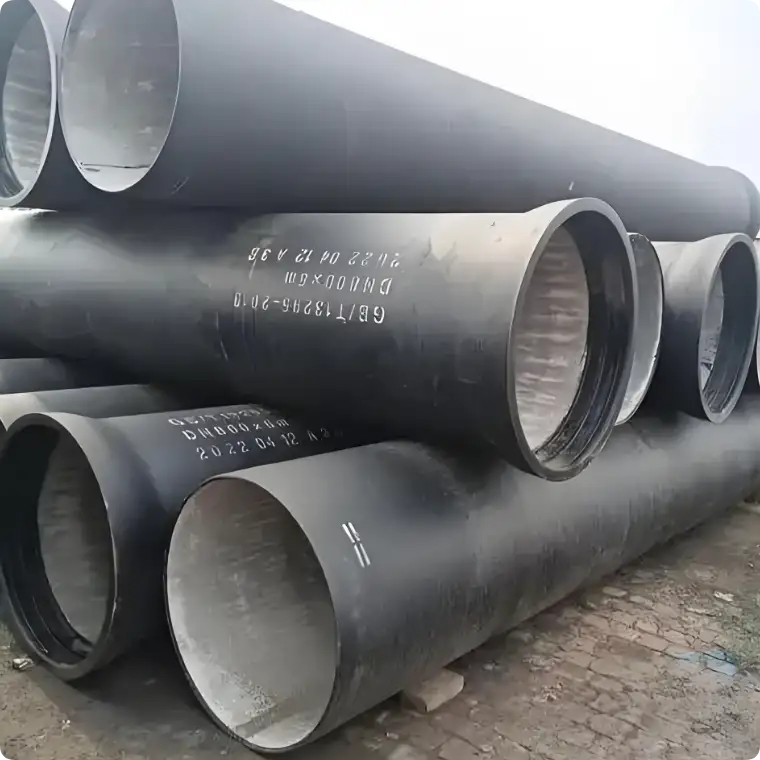When selecting piping materials for infrastructure projects, two common options are ductile iron pipes (DIP) and steel pipes. Each material has distinct characteristics that influence their suitability for various applications.

Material Properties
Ductile Iron Pipe (DIP)
Ductile iron is a type of cast iron that has been treated with magnesium to form spheroidal graphite nodules. This treatment enhances its ductility and strength compared to traditional cast iron. DIP typically has a carbon content of 3.0%–3.9%, contributing to its hardness and strength.
Steel Pipe
Steel pipes are made from carbon steel, which has a lower carbon content (approximately 0.8%–0.6%) compared to ductile iron. This composition provides steel with high tensile strength and flexibility. However, steel pipes often require additional coatings to prevent corrosion.
Applications
Ductile Iron Pipe
DIP is widely used in water and wastewater systems, including potable water distribution, sewage systems, and stormwater management. Its resistance to corrosion and ability to handle high internal pressures make it ideal for these applications.
Steel Pipe
Steel pipes are commonly used in oil and gas pipelines, structural applications, and industrial processes. Their strength and flexibility are advantageous in environments where high pressure and mechanical stress are prevalent.
Cost and Economic Considerations
Generally, ductile iron pipes are more cost-effective for standard water and wastewater applications. They often require less maintenance and have a longer service life, leading to lower total lifecycle costs. Steel pipes, while potentially less expensive upfront, may incur higher maintenance costs due to their susceptibility to corrosion and the need for protective coatings .
Installation and Handling
Ductile Iron Pipe
DIP is typically supplied with a corrosion-resistant coating, such as polyethylene encasement, which is applied at the job site. This method reduces the risk of coating damage during transport and installation . Installation is straightforward, with various jointing methods available, including push-on and mechanical joints.
Steel Pipe
Steel pipes require bonded coatings, such as cement-mortar or tape-wrap, for corrosion protection. These coatings can be susceptible to damage during handling and installation, potentially compromising their effectiveness. Welding is commonly used to join steel pipes, which may require additional labor and equipment.
International Standards
Ductile iron pipes are designed according to the ANSI/AWWA C150/A21.50 standard, which incorporates a conservative safety factor of 2.0. This standard provides guidelines for wall thickness based on working and surge pressures, ensuring reliability and safety .
Steel pipes are designed under various standards, including the American Water Works Association’s Manual M11 and the American Iron and Steel Institute’s guidelines. However, these standards may allow for higher stress levels, with safety factors ranging from 1.33 to 2.0, depending on the yield strength used .
Advantages of Ductile Iron Pipe
-
Corrosion Resistance: DIP’s corrosion-resistant coatings and materials enhance its longevity and reduce maintenance needs.
-
Energy Efficiency: Larger internal diameters of DIP result in lower pumping costs and energy savings.
-
Safety: The conservative design standards of DIP provide a higher safety margin under pressure conditions.
Maintenance and Durability
Ductile iron pipes generally offer a longer service life with minimal maintenance requirements. Their resistance to corrosion and robust design contribute to fewer repairs and replacements over time. Steel pipes, while strong, may require more frequent maintenance due to potential corrosion and the need for protective coatings.
Both ductile iron and steel pipes have their merits, and the choice between them depends on specific project requirements. Ductile iron pipes are often preferred for water and wastewater systems due to their durability, cost-effectiveness, and adherence to stringent standards. Steel pipes may be suitable for applications requiring high strength and flexibility, such as in the oil and gas industry. Careful consideration of material properties, application needs, and long-term costs is essential in making the optimal selection for any piping project.

